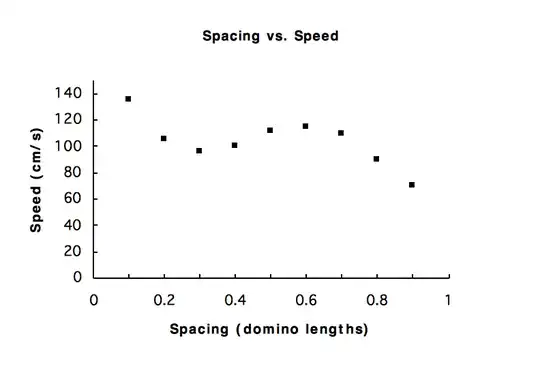A falling domino has rotational acceleration of $$\ddot{\theta} = \frac{3 g}{2 \sqrt{h^2 + w^2}} \sin \left( \theta - \tan^{-1} \left( \tfrac{w}{h} \right) \right) $$
where $g$ is gravity, $h$ is the domino height, $w$ is the domino width and $\theta$ the tilt angle. The above is solved in terms of rotational velocity if one assumes the initial rotational velocity (after impact) is $\omega$
$$ \dot{\theta}^2 = \omega^2 + \frac{3 g}{h} \frac{h \sqrt{h^2+w^2}-w (s-w)-h \sqrt{h^2-(s-w)^2}}{h^2+w^2} $$
where $s$ is the separation between dominos (not the gap, but the distance between the centers).
The trick now is for the falling domino with $\dot{\theta}$ to impact an upright one resulting in speed $\omega$. To find this, one needs the reduced mass $\mu$ of the system along the contact normal. If each domino has mass $m$, then the reduced mass is
$$ \frac{ \mu}{m} = \tfrac{h^2 (h^2+w^2)}{44 h^4 + 3 w^2 (s-w)^2 - h^2 (39 s^2-78 s w + 37 w^2)+6 h \sqrt{h^2-(s-w)^2}(2 h^2 +3 w (s-w))} $$
The speed of the contact point being $v_{impact} =\dot{\theta} \sqrt{h^2 - (s-w)^2}$ and the exchanged momentum $J = \mu\, v_{impact}$ (assuming coefficient of restitution equals 0)
As a result, the initial (rotational) speed of the next domino after impact is
$$ \omega = \frac{ \dot{\theta} 6 h^2}{h^2+w^2} \tfrac{ h (h^2+w^2) \sqrt{h^2-(s-w)^2}+2 h^4+2 h^2 s (2 w-s)-2 w^2 (s-w)^2}{44 h^2+3 w^2 (s-w)^2-h^2 (39 a^2-78 s w + 37 w^2) + 6 h \sqrt{h^2-(s-w)^2} (2 h^2 +3 w (s-w))}$$
Combine the 2nd with the 4th expression from above to solve for the initial rotational speed of the domino
$$ \omega^2 = \frac{ 1 - \tfrac{(h^2+w^2)^2 \left(6 h \sqrt{h^2-(s-w)^2}(2 h^2+3 w (s-w))+44 h^2 - h^2 (39 s^2-78 s w+37 w^2)+3 w^2 (s-w)^2\right)^2}{36 h^4 \left(h (h^2+w^2) \sqrt{h^2-(s-w)^2}+2 h^4+2 h^2 s (2 w-s) -2 w^2 (s-w)^2 \right)^2}}{\tfrac{3 g (h \sqrt{h^2-(s-w)^2}-h \sqrt{h^2+w^2}+w (s-w)}{h (h^2+w^2)}} $$
Reference: Calculate force between rotating objects and Impulsive angular momentum.

